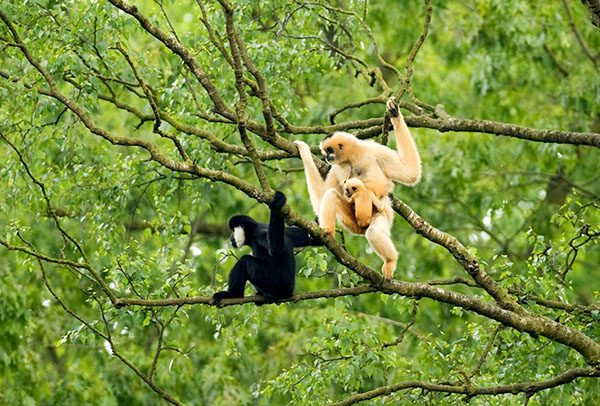Tailor Made Holidays with our travel experts
We'll do our best to call you within 48h

Pu Mat National Park (Vietnamese: Vườn quốc gia Pù Mát) is a national park in Nghệ An Province, in Vietnam's North Central Coast region. It is part of the Western Nghe An Biosphere reserve.
In the Thai language, Pù Mát means "high slope." This park was established by Decision 174/2001/QĐ-TTg, dated November 8, 2001, by the Prime Minister of Vietnam on upgrading Pu Mat Preservation Zone. This park is situated from N 18°46′to 19°12′and from E 104°24′to 104°56′. The park covers an area of 94,804 ha, spreading in three districts of Tương Dương, Con Cuông and Anh Sơn of Nghệ An Province. Of the total area, the strictly protected area comprises 89.517 ha, and the ecological recovery area comprises 1.596 ha. A buffer area covers 86.000 ha.
The priceless gift of the nature
According to the Thai language, Pu Mat means a mountain peak. Pu Mat is the highest peak in the area (1.841m) and was named to the national park. The beauty of Pu Mat is pristine and little touch of human hands. Coming here, visitors will admire the wild character of primeval forest with high levels of biodiversity in Vietnam and discover ethnic minorities having the unique cultures.
Spreading over Tuong Duong, Con Cuong and Anh Son districts, Pu Mat is the residence of the Thai ethnic group. The wild majestic mountainous beauty is mixed with a unique exquisite Thai culture. They live in wooden stilts houses with rice cultivation. In the hills, they participate in planting, raising livestock and poultry, making rattan products and weaving.
Thai brocade is renowned for its unique, colorful and durable features. Keeping a long tradition, each Thai community has its own beliefs and practices with the festivities associated with the bumper crops and agricultural production. Bamboo dancing and drinking “ruou can” (tube wine) are characterized in the daily life of the Thai people.
The Kinh group and and Dan Lai ethnic group live here. Dan Lai people are concentrated in 3 villages (Co Phat, Ban Con and Ban Bung) in Mon Son commune, located in the southeast of the Pu Mat National Park. They are living and farming on steep slopes. Coming to Pu Mat, visitors will admire the ancient forest in Tam Dinh commune, Tuong Duong district.
Also visitors can immerse in the coolness of Khe Kem waterfall (aka Kem waterfall) in the sweltering heat of central Vietnam. Located in 20 km of Con Cuong town to the south, this waterfall is spectacular at an altitude of 150m. Many scientists confirmed that this waterfall was almost the most pristine in Vietnam. The road to the waterfall is crooked, winding and bumpy. Thai people call it Bo Bo (white silk string). From the foot of the waterfall, you will feel that the endless stream flow in the white foam strip is like an endless white silk string.
Another strange thing is almost rare in Pu Mat that on the small boats on Giang River, visitors will return to the true nature, where man is only a small part of nature. The banks are pristine trees with majestic limestone mountains.
These unique characteristics
Pu Mat National Park is the place of the world to discover a rare species: Saola. Also it has 2494 species of plants, 132 species of mammals, 361 species of birds, 53 species of reptiles, 33 species of amphibians, 83 species of fish, 39 species of bats, and 1,080 species of insects. Of which many species of rare plants are under threat including 69 species of plants and 70 species of of animal listed in the Red Data Book of Vietnam and the World Red Book.
Biodiversity values
2,461 plant species have been confirmed to occur at Pu Mat, some of which may be new to science; taxonomic work is currently underway to confirm this. The most widespread vegetation type in the national park is lowland evergreen forest.
Pu Mat is probably one of the most important sites for mammal conservation in Vietnam. The Social Forestry and Nature Conservation in Nghe An Province (SFNC) surveys and research have confirmed the presence of five mammals endemic to Indochina: Northern White-cheeked Gibbon, Red-shanked Douc, Saola, Truong Son Muntjac and Annamite Striped Rabbit. The SFNC studies also confirmed the continued occurrence a number of other globally threatened mammals at Pu Mat, including Assamese Macaque, Dhole, Indochinese Tiger and Asian Elephant.
A "substantial" population of 455 critically endangered northern white-cheeked crested gibbons (Nomascus leucogenys) have been recently found living in the Pu Mat National Park in Nghe An province, northern Vietnam, near the border with Laos. Conservation International report they are living at high altitudes, and far from human settlements. This population, representing two thirds of the total known in Vietnam are, apparently, the "only confirmed viable population" of this variety in the world.